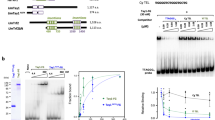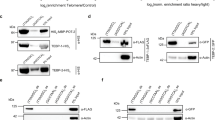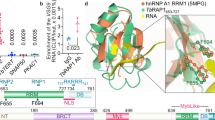Abstract
Telomere repeat-binding factors (TRFs) are essential components of the molecular machinery that regulates telomere function. TRFs are widely conserved across eukaryotes and bind duplex telomere repeats via a characteristic MYB-type domain. Here, we identified the telomere repeat-binding protein PfTRZ in the malaria parasite Plasmodium falciparum, a member of the Alveolate phylum for which TRFs have not been described so far. PfTRZ lacks an MYB domain and binds telomere repeats via a C2H2-type zinc finger domain instead. In vivo, PfTRZ binds with high specificity to the telomeric tract and to interstitial telomere repeats upstream of subtelomeric virulence genes. Conditional depletion experiments revealed that PfTRZ regulates telomere length homeostasis and is required for efficient cell cycle progression. Intriguingly, we found that PfTRZ also binds to and regulates the expression of 5S rDNA genes. Combined with detailed phylogenetic analyses, our findings identified PfTRZ as a remote functional homologue of the basic transcription factor TFIIIA, which acquired a new function in telomere maintenance early in the apicomplexan lineage. Our work sheds unexpected new light on the evolution of telomere repeat-binding proteins and paves the way for dissecting the presumably divergent mechanisms regulating telomere functionality in one of the most deadly human pathogens.
This is a preview of subscription content, access via your institution
Access options
Access Nature and 54 other Nature Portfolio journals
Get Nature+, our best-value online-access subscription
$29.99 / 30 days
cancel any time
Subscribe to this journal
Receive 12 digital issues and online access to articles
$119.00 per year
only $9.92 per issue
Buy this article
- Purchase on Springer Link
- Instant access to full article PDF
Prices may be subject to local taxes which are calculated during checkout





Similar content being viewed by others
References
O'Sullivan, R. J. & Karlseder, J. Telomeres: protecting chromosomes against genome instability. Nat. Rev. Mol. Cell Biol. 11, 171–181 (2010).
Martinez, P. & Blasco, M. A. Replicating through telomeres: a means to an end. Trends Biochem. Sci. 40, 504–515 (2015).
Xin, H., Liu, D. & Songyang, Z. The telosome/shelterin complex and its functions. Genome Biol. 9, 232 (2008).
Broccoli, D., Smogorzewska, A., Chong, L. & de Lange, T. Human telomeres contain two distinct Myb-related proteins, TRF1 and TRF2. Nat. Genet. 17, 231–235 (1997).
Zhong, Z., Shiue, L., Kaplan, S. & de Lange, T. A mammalian factor that binds telomeric TTAGGG repeats in vitro. Mol. Cell Biol. 12, 4834–4843 (1992).
Vassetzky, N. S., Gaden, F., Brun, C., Gasser, S. M. & Gilson, E. Taz1p and Teb1p, two telobox proteins in Schizosaccharomyces pombe, recognize different telomere-related DNA sequences. Nucleic Acids Res. 27, 4687–4694 (1999).
Brigati, C., Kurtz, S., Balderes, D., Vidali, G. & Shore, D. An essential yeast gene encoding a TTAGGG repeat-binding protein. Mol. Cell Biol. 13, 1306–1314 (1993).
Lee, W. K., Yun, J. H., Lee, W. & Cho, M. H. DNA-binding domain of AtTRB2 reveals unique features of a single Myb histone protein family that binds to both Arabidopsis- and human-type telomeric DNA sequences. Mol. Plant 5, 1406–1408 (2012).
Li, B., Espinal, A. & Cross, G. A. Trypanosome telomeres are protected by a homologue of mammalian TRF2. Mol. Cell Biol. 25, 5011–5021 (2005).
Koering, C. E. et al. Identification of high affinity Tbf1p-binding sites within the budding yeast genome. Nucleic Acids Res. 28, 2519–2526 (2000).
Longtine, M. S., Wilson, N. M., Petracek, M. E. & Berman, J. A yeast telomere binding activity binds to two related telomere sequence motifs and is indistinguishable from RAP1. Curr. Genet. 16, 225–239 (1989).
Giraud-Panis, M. J., Pisano, S., Poulet, A., Le Du, M. H. & Gilson, E. Structural identity of telomeric complexes. FEBS Lett. 584, 3785–3799 (2010).
Cooper, J. P., Nimmo, E. R., Allshire, R. C. & Cech, T. R. Regulation of telomere length and function by a Myb-domain protein in fission yeast. Nature 385, 744–747 (1997).
Marcand, S., Wotton, D., Gilson, E. & Shore, D. Rap1p and telomere length regulation in yeast. Ciba Found. Symp. 211, 76–93 (1997).
Pardo, B. & Marcand, S. Rap1 prevents telomere fusions by nonhomologous end joining. EMBO J. 24, 3117–3127 (2005).
van Steensel, B., Smogorzewska, A. & de Lange, T. TRF2 protects human telomeres from end-to-end fusions. Cell 92, 401–413 (1998).
van Steensel, B. & de Lange, T. Control of telomere length by the human telomeric protein TRF1. Nature 385, 740–743 (1997).
Miller, K. M., Rog, O. & Cooper, J. P. Semi-conservative DNA replication through telomeres requires Taz1. Nature 440, 824–828 (2006).
Sfeir, A. et al. Mammalian telomeres resemble fragile sites and require TRF1 for efficient replication. Cell 138, 90–103 (2009).
Stansel, R. M., de Lange, T. & Griffith, J. D. T-loop assembly in vitro involves binding of TRF2 near the 3′ telomeric overhang. EMBO J. 20, 5532–5540 (2001).
Tomaska, L., Willcox, S., Slezakova, J., Nosek, J. & Griffith, J. D. Taz1 binding to a fission yeast model telomere: formation of telomeric loops and higher order structures. J. Biol. Chem. 279, 50764–50772 (2004).
Tham, W. H. & Zakian, V. A. Transcriptional silencing at Saccharomyces telomeres: implications for other organisms. Oncogene 21, 512–521 (2002).
Benetti, R., Schoeftner, S., Munoz, P. & Blasco, M. A. Role of TRF2 in the assembly of telomeric chromatin. Cell Cycle 7, 3461–3468 (2008).
Voss, T. S., Bozdech, Z. & Bartfai, R. Epigenetic memory takes center stage in the survival strategy of malaria parasites. Curr. Opin. Microbiol. 20, 88–95 (2014).
Figueiredo, L. M., Freitas-Junior, L. H., Bottius, E., Olivo-Marin, J. C. & Scherf, A. A central role for Plasmodium falciparum subtelomeric regions in spatial positioning and telomere length regulation. EMBO J. 21, 815–824 (2002).
Vernick, K. D. & McCutchan, T. F. Sequence and structure of a Plasmodium falciparum telomere. Mol. Biochem. Parasitol. 28, 85–94 (1988).
De Cian, A. et al. Plasmodium telomeric sequences: structure, stability and quadruplex targeting by small compounds. ChemBioChem 9, 2730–2739 (2008).
Figueiredo, L. M. et al. The unusually large Plasmodium telomerase reverse-transcriptase localizes in a discrete compartment associated with the nucleolus. Nucleic Acids Res. 33, 1111–1122 (2005).
Marsellach, F. X., Huertas, D. & Azorin, F. The multi-KH domain protein of Saccharomyces cerevisiae Scp160p contributes to the regulation of telomeric silencing. J. Biol. Chem. 281, 18227–18235 (2006).
Du, Z., Yu, J., Chen, Y., Andino, R . & James, T. L. Specific recognition of the C-rich strand of human telomeric DNA and the RNA template of human telomerase by the first KH domain of human poly(C)-binding protein-2. J. Biol. Chem. 279, 48126–48134 (2004).
Persikov, A. V. & Singh, M. De novo prediction of DNA-binding specificities for Cys2His2 zinc finger proteins. Nucleic Acids Res. 42, 97–108 (2014).
Flueck, C. et al. Plasmodium falciparum heterochromatin protein 1 marks genomic loci linked to phenotypic variation of exported virulence factors. PLoS Pathog. 5, e1000569 (2009).
Guizetti, J. & Scherf, A. Silence, activate, poise and switch! Mechanisms of antigenic variation in Plasmodium falciparum. Cell Microbiol. 15, 718–726 (2013).
Lavstsen, T., Salanti, A., Jensen, A. T., Arnot, D. E. & Theander, T. G. Sub-grouping of Plasmodium falciparum 3D7 var genes based on sequence analysis of coding and non-coding regions. Malar. J. 2, 27 (2003).
Brancucci, N. M. et al. Heterochromatin protein 1 secures survival and transmission of malaria parasites. Cell Host Microbe 16, 165–176 (2014).
Flueck, C. et al. A major role for the Plasmodium falciparum ApiAP2 protein PfSIP2 in chromosome end biology. PLoS Pathog. 6, e1000784 (2010).
Banaszynski, L. A., Chen, L. C., Maynard-Smith, L. A., Ooi, A. G. & Wandless, T. J. A rapid, reversible, and tunable method to regulate protein function in living cells using synthetic small molecules. Cell 126, 995–1004 (2006).
Layat, E., Probst, A. V. & Tourmente, S. Structure, function and regulation of transcription factor IIIA: from Xenopus to Arabidopsis. Biochim. Biophys. Acta 1829, 274–282 (2013).
Liao, X. B., Clemens, K. R., Tennant, L., Wright, P. E. & Gottesfeld, J. M. Specific interaction of the first three zinc fingers of TFIIIA with the internal control region of the Xenopus 5 S RNA gene. J. Mol. Biol. 223, 857–871 (1992).
Soding, J., Biegert, A . & Lupas, A. N. The HHpred interactive server for protein homology detection and structure prediction. 33, W244–W248 (2005).
Wasmuth, J., Daub, J., Peregrin-Alvarez, J. M., Finney, C. A. & Parkinson, J. The origins of apicomplexan sequence innovation. Genome Res. 19, 1202–1213 (2009).
Seetharam, A. & Stuart, G. W. A study on the distribution of 37 well conserved families of C2H2 zinc finger genes in eukaryotes. BMC Genomics 14, 420 (2013).
Li, J. S. et al. TZAP: a telomere-associated protein involved in telomere length control. Science 355, 638–641 (2017).
Li, L., Stoeckert, C. J. Jr & Roos, D. S. OrthoMCL: identification of ortholog groups for eukaryotic genomes. Genome Res. 13, 2178–2189 (2003).
Finn, R. D., Clements, J. & Eddy, S. R. HMMER web server: interactive sequence similarity searching. Nucleic Acids Res. 39, W29–W37 (2011).
Religa, A. A., Ramesar, J., Janse, C. J., Scherf, A. & Waters, A. P. P. Berghei telomerase subunit TERT is essential for parasite survival. PLoS ONE 9, e108930 (2014).
Yang, D. et al. Human telomeric proteins occupy selective interstitial sites. Cell Res. 21, 1013–1027 (2011).
Bosco, N. & de Lange, T. A TRF1-controlled common fragile site containing interstitial telomeric sequences. Chromosoma 121, 465–474 (2012).
Stanton, A., Harris, L. M., Graham, G. & Merrick, C. J. Recombination events among virulence genes in malaria parasites are associated with G-quadruplex-forming DNA motifs. BMC Genomics 17, 859 (2016).
Pain, A. et al. The genome of the simian and human malaria parasite Plasmodium knowlesi. Nature 455, 799–803 (2008).
Trager, W. & Jensen, J. B. Cultivation of malarial parasites. Nature 273, 621–622 (1978).
Voss, T. S. et al. A var gene promoter controls allelic exclusion of virulence genes in Plasmodium falciparum malaria. Nature 439, 1004–1008 (2006).
Lambros, C. & Vanderberg, J. P. Synchronization of Plasmodium falciparum erythrocytic stages in culture. J. Parasitol. 65, 418–420 (1979).
Witmer, K. et al. Analysis of subtelomeric virulence gene families in Plasmodium falciparum by comparative transcriptional profiling. Mol. Microbiol. 84, 243–259 (2012).
Birnbaum, J. et al. A genetic system to study P. falciparum protein function. Nat Methods http://dx.doi.org/10.1038/nmeth.4223 (2017).
van Schaijk, B. C., Vos, M. W., Janse, C. J., Sauerwein, R. W. & Khan, S. M. Removal of heterologous sequences from Plasmodium falciparum mutants using FLPe-recombinase. PLoS ONE 5, e15121 (2010).
Voss, T. S., Kaestli, M., Vogel, D., Bopp, S. & Beck, H. P. Identification of nuclear proteins that interact differentially with Plasmodium falciparum var gene promoters. Mol. Microbiol. 48, 1593–1607 (2003).
Voss, T. S., Mini, T., Jenoe, P. & Beck, H. P. Plasmodium falciparum possesses a cell cycle-regulated short type replication protein A large subunit encoded by an unusual transcript. 277, 17493–17501 (2002).
Gibson, D. G. et al. Enzymatic assembly of DNA molecules up to several hundred kilobases. Nat. Methods 6, 343–345 (2009).
Kensche, P. R. et al. The nucleosome landscape of Plasmodium falciparum reveals chromatin architecture and dynamics of regulatory sequences. Nucleic Acids Res. 44, 2110–2124 (2016).
Zhang, Y. et al. Model-based analysis of ChIP-Seq (MACS). Genome Biol. 9, R137 (2008).
Bozdech, Z. et al. The transcriptome of the intraerythrocytic developmental cycle of Plasmodium falciparum. PLoS Biol. 1, E5 (2003).
Painter, H. J., Altenhofen, L. M., Kafsack, B. F. & Llinas, M. Whole-genome analysis of Plasmodium spp. utilizing a new agilent technologies DNA microarray platform. Methods Mol. Biol. 923, 213–219 (2013).
Edgar, R., Domrachev, M. & Lash, A. E. Gene expression omnibus: NCBI gene expression and hybridization array data repository. Nucleic Acids Res. 30, 207–210 (2002).
Vilella, A. J. et al. EnsemblCompara GeneTrees: complete, duplication-aware phylogenetic trees in vertebrates. Genome Res. 19, 327–335 (2009).
Xiong, X. et al. PhyloPro: a web-based tool for the generation and visualization of phylogenetic profiles across Eukarya. Bioinformatics 27, 877–878 (2011).
Aurrecoechea, C. et al. PlasmoDB: a functional genomic database for malaria parasites. 37, D539–D543 (2009).
Altschul, S. F., Gish, W., Miller, W., Myers, E. W. & Lipman, D. J. Basic local alignment search tool. J. Mol. Biol. 215, 403–410 (1990).
Sievers, F. et al. Fast, scalable generation of high-quality protein multiple sequence alignments using Clustal Omega. Mol. Syst. Biol. 7, 539 (2011).
Capella-Gutierrez, S., Silla-Martinez, J. M. & Gabaldon, T. trimAl: a tool for automated alignment trimming in large-scale phylogenetic analyses. Bioinformatics 25, 1972–1973 (2009).
Abascal, F., Zardoya, R. & Posada, D. ProtTest: selection of best-fit models of protein evolution. Bioinformatics 21, 2104–2105 (2005).
Guindon, S. et al. New algorithms and methods to estimate maximum-likelihood phylogenies: assessing the performance of PhyML 3.0. Syst. Biol. 59, 307–321 (2010).
Ronquist, F. & Huelsenbeck, J. P. Mrbayes 3: Bayesian phylogenetic inference under mixed models. Bioinformatics 19, 1572–1574 (2003).
Hunter, S. et al. InterPro: the integrative protein signature database. Nucleic Acids Res. 37, D211–D215 (2009).
Li, W. & Godzik, A. Cd-hit: a fast program for clustering and comparing large sets of protein or nucleotide sequences. Bioinformatics 22, 1658–1659 (2006).
Kearse, M. et al. Geneious basic: an integrated and extendable desktop software platform for the organization and analysis of sequence data. Bioinformatics 28, 1647–1649 (2012).
Katoh, K., Misawa, K., Kuma, K. & Miyata, T. MAFFT: a novel method for rapid multiple sequence alignment based on fast Fourier transform. Nucleic Acids Res. 30, 3059–3066 (2002).
Rice, P., Longden, I. & Bleasby, A. EMBOSS: the European molecular biology open software suite. Trends Genet. 16, 276–277 (2000).
Enright, A. J., Van, D. S. & Ouzounis, C. A. An efficient algorithm for large-scale detection of protein families. Nucleic Acids Res. 30, 1575–1584 (2002).
Shannon, P. et al. Cytoscape: a software environment for integrated models of biomolecular interaction networks. Genome Res. 13, 2498–2504 (2003).
Acknowledgements
The authors thank R. Sauerwein for providing the anti-Pfs16 antibody and S. Hiller for providing the pGB1 plasmid. This work was supported by the Swiss National Science Foundation (grant nos. PP00P3_130203 and 31003A_143916), the OPO and Rudolf Geigy Foundations, the Novartis Foundation for Medical-Biological Research (grant no. 14A33), the Natural Sciences and Engineering Research Council of Canada (no. RGPIN-2014-06664) and the Netherlands Organization for Scientific Research (no. NWO-Vidi 864.11.007).
Author information
Authors and Affiliations
Contributions
N.L.B. designed and performed experiments, analysed data, prepared illustrations and wrote the paper. C.G.T. performed and analysed ChIP-Seq experiments. I.N. designed and performed experiments related to recombinant protein expression and EMSAs. R.H. generated the 3D7/TRZHA parasite line. S.M. performed LC-MS/MS experiments. P.J. provided conceptual advice. P.J., R.B. and T.S.V. provided resources. R.B. designed and supervised experiments and interpreted data. J.P. supervised and designed evolutionary analyses. A.Z. conducted evolutionary analyses. T.S.V. conceived the study and designed, supervised and analysed experiments and wrote the paper. All authors contributed to editing the manuscript.
Corresponding author
Ethics declarations
Competing interests
The authors declare no competing financial interests.
Supplementary information
Supplementary Information
Supplementary Figures 1-6 and Supplementary Tables 1-4. (PDF 1905 kb)
Supplementary Data 1
This file lists all proteins and peptides identified by Mascot and SEQUEST HT searches of the results obtained from LC-MS/MS analysis of nuclear proteins affinity-purified using immobilised Tel6mer DNA (worksheet 1) or scrTel6mer DNA (negative control) (worksheet 2). (XLSX 310 kb)
Supplementary Data 2
This file lists the processed microarray data. (XLSX 693 kb)
Supplementary Data 3
This file groups all 1488 C2H2-type ZnF proteins of the protein similarity network (Fig. 5a) into clusters of related sequences. (XLSX 31 kb)
Supplementary Data 4
This file contains a multiple alignment of all sequences contained in the sequence similarity network of 1488 C2H2-type ZnF proteins (Fig. 5a). (TXT 302 kb)
Rights and permissions
About this article
Cite this article
Bertschi, N., Toenhake, C., Zou, A. et al. Malaria parasites possess a telomere repeat-binding protein that shares ancestry with transcription factor IIIA. Nat Microbiol 2, 17033 (2017). https://doi.org/10.1038/nmicrobiol.2017.33
Received:
Accepted:
Published:
DOI: https://doi.org/10.1038/nmicrobiol.2017.33



